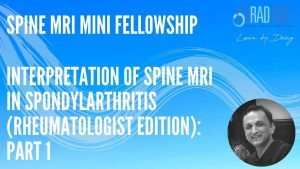MRI SPINE FOR RHEUMATOLOGISTS & (RADIOLOGISTS )
)
In this video below we look at how to assess a MRI Spine Ankylosing Spondylitis & Spondyloarthritis (SpA ) for Rheumatologists (and Radiologists 
This is the 2nd part of a 3 part series on How to assess Ankylosing spondylitis and Spondyloarthritis ( SpA) on MRI. If you haven’t seen the 1st part of this series go back to this link CLICK HERE FOR PART 1.
In this video we look at:
- What are the different types of Signal that we need to know about and look for
- What that signal means.
- And how it relates to the pathological changes that are occurring in Ankylosing Spondylitis and SpA.
If you find this video helpful, please subscribe to our YouTube channel.
If your Browser is blocking the video, Please Click HERE to view it on our YouTube channel.
We go into more detail with videos, dicoms, quizzes and the ability for you to ask questions to clear doubts about Ankylosing Spondylitis, Spondyloarthritis SpA and Arthritis Imaging in our Guided MRI Spine Spondyloarthritis and Arthritis Mini Fellowship.
Click on the image below for more information.
For all our other current MSK MRI & Spine MRI
Online Guided Mini Fellowships.
Click on the image below for more information.
- Join our WhatsApp Group for regular educational posts. Message “JOIN GROUP” to +6594882623 (your name and number remain private and cannot be seen by others).
- Get our weekly email with all our educational posts: https://bit.ly/whathappendthisweek
Rheumatologists and radiologists should be able to assess a MRI Spine for changes of Ankylosing Spondylitis and Spondyloarthritis and develop a basic understanding of what to look for and where to look.
This video is the 2nd video in a 3 part series for Rheumatologists (and Radiologists 😀) on how to have a structure to assess a MRI spine and what to look for.
We will follow this up in Part 3 by looking at:
- How to have a structure to look at a spine MRI.
- What are the various abnormalities we need to look or in an MRI of the Spine in Ankylosing spondylitis and spondyloarthropathy.
The talk was delivered for IRACON 21 held by the Indian Rheumatologists Association.
All right we've talked about sequences what about signal there are a couple of things that you need to know about signal so signal really in a gross way reflects the pathological progression of the disease okay so this is a very grossly simplified uh slide but it's a good way of just getting across what you need to know so with SpA as you know the initial response is inflammation and erosions then subsequently with time you get a healing response and then eventually you may or may not get ossification so the imaging findings also will reflect this if we look at the corresponding imaging changes when you have inflammation what you will see on imaging is edema when you have a healing response so the inflammation reduces starts this healing response that often shows up as fat metaplasia increased amount of fat deposition in that area of inflammation and the later stage when you have ossification what we'll be looking for is new bone formation or ankylosis on imaging so this is a rough guide to how the imaging corresponds with the pathological changes that occur.
What do we look for although this is a talk about spine I'm going to show this on sacroiliac joint because the changes are much larger and they're easier to appreciate but it's exactly the same change that will occur in the spine so if we're looking for edema inflammatory changes the best sequence to assess that on is the t2 fat saturated sequence so this is like the go-to sequence when you start looking at the scan go to the t2 fat saturate the sequence or stir sequence and look for bright signal so here we have the sacrum this is a coronal scan this is the sacroiliac joint and you can see that there's really bright signal adjacent to that SIJ remainder of the sacrum here is low signal so that's just normal fat and on the iliac side we also have some mildly increased signal so we've got edema inflammatory changes present within the bone now if you happen to give contrast that will enhance inflammation usually enhances but we don't really need to worry about this because it's not common to give contrast but if we go back to the t1 what you notice is that there is some low signal here compared to the rest of the sacrum however you can see how much easier it is to see this inflammation on the t2 fat set rather than the t1 so this is the best sequence for you to assess edema or inflammation i suggest you start with that sequence to look for active inflammatory changes okay what about that when it starts to get the healing type response or the more chronic response so really what we're looking for is fat metaplasia and fat metaplasia is the replacement of that area of inflammation with fatty change so if we go back to this these are different patients so we've got this area of intense inflammation so in this patient previously they would also had inflammation here but now on this t1 weighted signal we've got bright signal so this is fat and you can see on the stir sequence that area is not bright anymore it's it's dark so it tells you that this is fat so this is fatty metaplasia and it's an indication of a healing response there's been previous inflammation here but has now resolved we will also look for erosions we can look for sclerosis or sclerosis it is low signal on all sequences is basically dense bone and then at the end stage we get ankylosis if we look at the patient's left side joint we can see that there is a joint here there is erosion that's irregular but the joint is still maintained if we look at the patient's right we have fat metaplasia so this increased fat adjacent to the si joint but we also have this fat signal this marrow signal that is going across the joint there's no normal joint there anymore and similarly it's filling with ossification here so this is the changes of ossification that we will see we basically see new bone formation, new marrow.
okay so what does MRI tell us about the types of changes basically we can work out from MRI is there active inflammatory change so is there active disease or are the changes more chronic and structural with less active change and more chronic changes which won't result so if we look at active changes what these are really active inflammatory changes you have active disease and the way it reflects on MRI is that we have a demon we have bright t2 fat-sat or stir signal and we can see that in the bones or we can see it in the ligaments or both and what it's telling you is that this is a potentially reversible stage so they've got active inflammatory changes treatment may help to reduce or resolve it and as we've said we're going to be looking for edema on the t2 fat saturated sequence and if we're looking then for structural changes what we're looking for are erosions for fat metaplasia for ankylosis and new bone formation these are more chronic changes it can be the bone or the ligaments and these are irreversible so once you get erosions once you get fat in that better place your ankylosis you can't reverse this with treatment so MRI helps you to stratify the changes in way of changes that are active potentially treatable and reversible and changes that are chronic and structural and cannot be changed.
#radedasia #mri #mskmri #radiology











